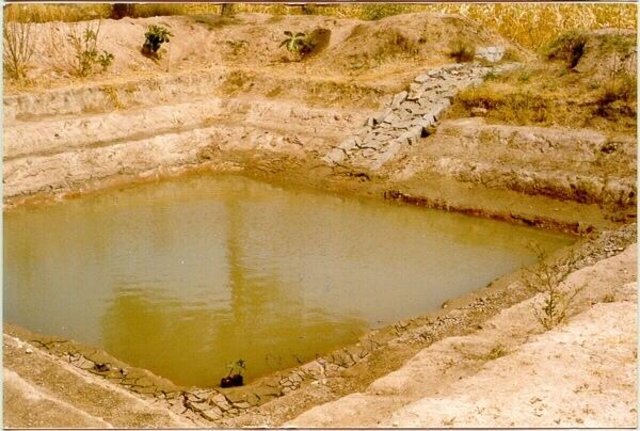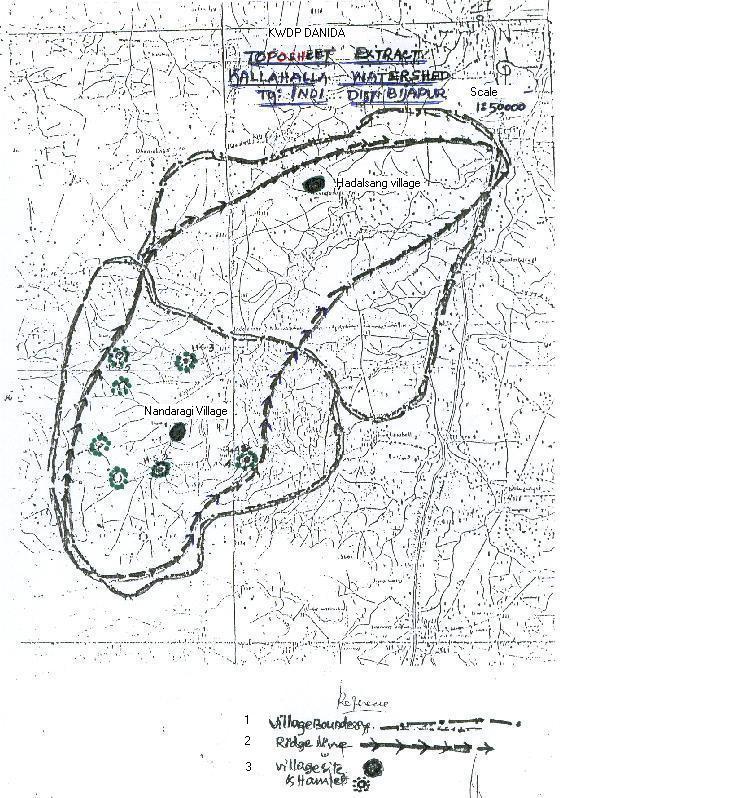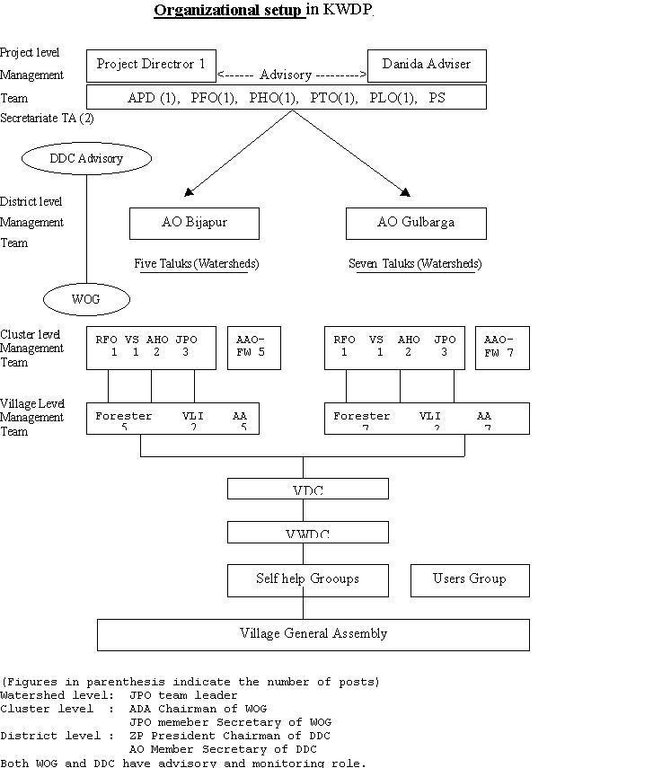Stakeholders participation in the project activities [India]
- Creation:
- Update:
- Compiler: Pranesh Jahagirdar
- Editor: –
- Reviewer: Fabian Ottiger
approaches_2373 - India
View sections
Expand all Collapse all1. General information
1.2 Contact details of resource persons and institutions involved in the assessment and documentation of the Approach
Name of the institution(s) which facilitated the documentation/ evaluation of the Approach (if relevant)
Danida assisted Karnataka Watershed Development Project, Bijapur (Danida assisted Karnataka Watershed Development Project, Bijapur) - India1.3 Conditions regarding the use of data documented through WOCAT
The compiler and key resource person(s) accept the conditions regarding the use of data documented through WOCAT:
Ja
1.4 Reference(s) to Questionnaire(s) on SLM Technologies

Farm pond [India]
A sunken structure (12 x 12 x 3 m, more suiable), constructed by escavation in arable land with a view of temporary runoff storage tapped for protective irrigation, and to increase percolation for recharge of ground water (to convert surface to subsurface flow)
- Compiler: Channabasappa Metri
2. Description of the SLM Approach
2.1 Short description of the Approach
SWC approach is a participatory methodology to empower the community to plan, implement, monitor, evaluate and manage the SWC technology to bring about sustainability
2.2 Detailed description of the Approach
Detailed description of the Approach:
Aims / objectives: (1) to develop a feeling of ownership, (2) to compare the management of assets created during and after the project in the sustainable manner, (3) to develop capacity amongst the weeker section of the community especially women and resource person, (4) to involve the community at every stage of implementation of the project.
Methods: (1) Participatory Rural Appriasal (PRA), (2) village resourse mapping, (3) training and exposure visits, (4) formation of self help groups, users groups, cattle brreders association, (5) sharing of costs and responsibility (6) partnership with other NGOs, (6) establishment of linkages and networking (7) empowering the coimmnunity throough the livelihood support programs
Stages of implementation: (1) creating awareness, (2) PRA excercises, (3) formation of village level institutions, (4) microplanning, (5) capacity building measures, (6) sharing of cost and responsibilities of management of common property resorses, (7) associating with NGOs and other institutions in rural development (example MANAGE, ICRISAT, University of Agricultural Sciences etc)
Role of stakeholders: (A) participants are of four category (1) project staff (government), (2) members of village level institutions, (3) NGOs and other link organizations and other institutions, (4) international donors (B) Roles :- (1) providing technical support and guidance at every stage of implementation, (2) participation at every stage of implementation, sharing of cost and responsibilities (3) Providing additional technical support (4) providing financial support, guidance, monitoring & evaluation at every stage of implementation.
2.3 Photos of the Approach
2.5 Country/ region/ locations where the Approach has been applied
Country:
India
Region/ State/ Province:
Krnataka state
Map
×2.6 Dates of initiation and termination of the Approach
Indicate year of initiation:
1997
Year of termination (if Approach is no longer applied):
2004
2.7 Type of Approach
- project/ programme based
2.8 Main aims/ objectives of the Approach
The Approach focused on SLM only (farm pond, waterharvesting, holistic demonstration)
(1) to develop a feeling of ownership, (2) to compare the management of assets created during and after the project in the sustainable manner, (3) to develop capacity amongst the weeker section of the community, especially women and resource poors, (4) to involve the community at every stage of implementation of the project
The SLM Approach addressed the following problems: (1) The problem addressed include non involvement of the community at different stages of implementation of the project. (2) Lack of empowerment and capacity for the deprived class of the community
2.9 Conditions enabling or hindering implementation of the Technology/ Technologies applied under the Approach
social/ cultural/ religious norms and values
- hindering
coming together of different community in the village, (2)over exploitation of natural resources
Treatment through the SLM Approach: organizing the village community into different village level institutions based on their ideology and background, (2) creating awareness about the equitable distribution and organized the users groups
availability/ access to financial resources and services
- hindering
lack of funds to carry out the activities (2) lack of feeling of ownership
Treatment through the SLM Approach: offered financial support using the cost, benefit and responsibility sharing concept
institutional setting
- hindering
lack of village level institutions to take effective implementations
Treatment through the SLM Approach: organised in the village community and establishing an authoritative body to plan, implement the structure
legal framework (land tenure, land and water use rights)
- hindering
The existing land ownership, land use rights / water rights moderately hindered the approach implementation The land use rights did not hinder in private land treatments but because of the encroachment of the common land the SWC technology cannot be effectively implemented.
knowledge about SLM, access to technical support
- hindering
use of high cost structure for SWC technology
Treatment through the SLM Approach: demonstration of low cost technical structures
3. Participation and roles of stakeholders involved
3.1 Stakeholders involved in the Approach and their roles
- local land users/ local communities
Village level institutiosn like SHG, UG, CBA, VWDC etc. Specific ethnic groups: Labmani community
Men participation is more in VWDC and CBA while women participation is more in SHGs. the long lasting culture that women remain back and the men lead. The same thing was observed during the initial stages hwever there was considerable change in their understanding and attitude in the following years. Small land holders being part of the VWDC having authority to make decision about the activity to be implemented, they come from different SHGs, who are basically resource poor land users
- NGO
- national government (planners, decision-makers)
Government of India/ Govt. of Karnataka, Department of Agriculture and watershed development department
- international organization
Danida
3.2 Involvement of local land users/ local communities in the different phases of the Approach
| Involvement of local land users/ local communities | Specify who was involved and describe activities | |
|---|---|---|
| initiation/ motivation | passive | Mainly:rapid/participatory rural appraisal; partly: interviews/questionnaires; There were the village meeting (gram sabha), group discussions, participatory rural appriasal tools were implemented. |
| planning | interactive | Mainly: interviews/questionnaires; partly: public meetings; The transect walks with farmers to their individual survey fields during preparation of action plans. |
| implementation | external support | Mainly: casual labour; partly: responsibility for major steps; The members of various village level institutions like VWDC used to be present while implementation of CWS activities on common land while those on their individual lands were taken care by respective farmers. Here the cost sharing was t |
| monitoring/ evaluation | self-mobilization | Mainly: measurements/observations; partly: reporting; As and when needed evaluation and status of the structures were taken care by both members and also individually. |
| Research | none |
3.3 Flow chart (if available)
3.4 Decision-making on the selection of SLM Technology/ Technologies
Specify who decided on the selection of the Technology/ Technologies to be implemented:
- mainly land users, supported by SLM specialists
Explain:
the land users want ot implement the activity in consultation with SWC specialists
Decisions on the method of implementing the SLM Technology were made by mainly by land users supported by SLM specialists
4. Technical support, capacity building, and knowledge management
4.1 Capacity building/ training
Was training provided to land users/ other stakeholders?
Ja
Specify who was trained:
- land users
- planners
Form of training:
- farmer-to-farmer
- demonstration areas
- public meetings
Form of training:
- exposure visits, subject matter trainings
Subjects covered:
Regular training were conducted on the subject matter and other technical aspects of various SWC to be implemented in the upper reach, middle reach and in the lower reach etc, for the farmers and other members of VLI, along with the regular other trainings on accounting & book keeping, capacity building etc.
4.2 Advisory service
Do land users have access to an advisory service?
Ja
Specify whether advisory service is provided:
- at permanent centres
Describe/ comments:
Name of method used for advisory service: group discussion, interaction, exposure visits; Key elements: group discussion, interaction, exposure visits; 1) Advisory service was carried out through: projects own extension structure and agents; Extension staff: mainly government employees 3) Target groups for extension: land users; Activities: subject matter trainings, orientation trainings etc
Advisory service is quite adequate to ensure the continuation of land conservation activities; Since the project staff has complete responsibility of the watershed and since all the staff is government staff, it is adequate for one watershed area.
4.3 Institution strengthening (organizational development)
Have institutions been established or strengthened through the Approach?
- yes, moderately
Specify the level(s) at which institutions have been strengthened or established:
- local
Specify type of support:
- capacity building/ training
4.4 Monitoring and evaluation
Is monitoring and evaluation part of the Approach?
Ja
Comments:
bio-physical aspects were regular monitored through observations
technical aspects were regular monitored through measurements
socio-cultural aspects were regular monitored through observations
economic / production aspects were regular monitored through measurements
area treated aspects were regular monitored through observations
no. of land users involved aspects were regular monitored through measurements
management of Approach aspects were regular monitored through observations
There were few changes in the Approach as a result of monitoring and evaluation: Like involving the people since day one of the project. First capacity development of the stakeholders and then implementing the activities etc. This would increase the sustainability of the project interventions.
4.5 Research
Was research part of the Approach?
Ja
Give further details and indicate who did the research:
Not applicable
5. Financing and external material support
5.1 Annual budget for the SLM component of the Approach
Comments (e.g. main sources of funding/ major donors):
Approach costs were met by the following donors: international (donation by the donor agency DANIDA): 90.0%; local community / land user(s) (cost sharing): 10.0%
5.3 Subsidies for specific inputs (including labour)
- equipment
| Specify which inputs were subsidised | To which extent | Specify subsidies |
|---|---|---|
| machinery | fully financed | |
- agricultural
| Specify which inputs were subsidised | To which extent | Specify subsidies |
|---|---|---|
| seeds | fully financed | |
| Seedlings and biocides | partly financed | |
- infrastructure
| Specify which inputs were subsidised | To which extent | Specify subsidies |
|---|---|---|
| Community infrastructure | partly financed | |
5.4 Credit
Was credit provided under the Approach for SLM activities?
Nee
6. Impact analysis and concluding statements
6.1 Impacts of the Approach
Did the Approach help land users to implement and maintain SLM Technologies?
- No
- Yes, little
- Yes, moderately
- Yes, greatly
Improvement in the farm development, orchard, silvi pasture etc., replication of the SWC technology etc.
Did the Approach improve issues of land tenure/ user rights that hindered implementation of SLM Technologies?
- No
- Yes, little
- Yes, moderately
- Yes, greatly
The participatory approach used by the project helped the community to come closure and understand each other problems and work for the village development. The problem is likely to be overcome in the near future.
Did other land users / projects adopt the Approach?
- No
- Yes, little
- Yes, moderately
- Yes, greatly
The other watershed development project in neighbourinng villages undertaken by KAWAD has also initiated the formationof cattle breeders association.
6.3 Sustainability of Approach activities
Can the land users sustain what has been implemented through the Approach (without external support)?
- uncertain
If no or uncertain, specify and comment:
At present due to the continuous support and maintenance of the project staff the lnd users are enthusiastic to use the approach to carry out the acivities but it will be premature to comment at this stage whether they continue to use the approach once no one visits them and make a follow up.
6.4 Strengths/ advantages of the Approach
| Strengths/ advantages/ opportunities in the land user’s view |
|---|
| it has helped them to learn new technology by involving themselves (How to sustain/ enhance this strength: other project/ programs should involve these) |
| they have developed feeling of ownership (How to sustain/ enhance this strength: other projects/ programs should allow them to make decisions) |
| learnt te importance of living in harmony and resolving the conflicts (How to sustain/ enhance this strength: conflict resolution should be top most priority while implementing other projects/ programs) |
| they feel that their capacity and skills are enhanced by organizing the village level institutions. (How to sustain/ enhance this strength: on going support in terms of training and exposure visits should be continued.) |
| Strengths/ advantages/ opportunities in the compiler’s or other key resource person’s view |
|---|
| Participatory approaches involves all the staeholders (How to sustain/ enhance this strength: in every other projects or programs the approach whould be continued.) |
| The land users should feel the ownership (How to sustain/ enhance this strength: feeling should be continue even after the withdrwal of the project for 1 or 2 years) |
| there will conntribution from all the stake holders (How to sustain/ enhance this strength: other government project should also develop the procedure of contribution) |
| it is te best tool to introduce the new technology (How to sustain/ enhance this strength: whenever the new technology is introduced all the stakeholders should be involved.) |
| Oppressed class of the people are also involved in the project activities (How to sustain/ enhance this strength: government projects/ programs should develop a system wherein the oppressed class in the community have a say over the decision making) |
6.5 Weaknesses/ disadvantages of the Approach and ways of overcoming them
| Weaknesses/ disadvantages/ risks in the land user’s view | How can they be overcome? |
|---|---|
| treatment of land with one of the forest activities and then SWC measures | more focus on the SWC approach |
| ridge line approach | taking up acivities in the lands which have been leftover during previous years |
| language problem when interacting with the people from the hamlets | better facilitating and involving the educated people of the hamlets while interacting |
| formation of the users group focusig activities after the planting work is over | organising the stakeholders in to UG before undertaking the activities. |
| not much imortance is given to the land users demands during the initial period especially regardnign field bunds | before planting and implementing the activities, landusers demands should be taken into consideration |
| Weaknesses/ disadvantages/ risks in the compiler’s or other key resource person’s view | How can they be overcome? |
|---|---|
| Low level of literacy | Regular training and capacity building trainings |
| shortage of women staff in the project restricting the interaction with the women land owners | Regular gender sensitization training to the project staff. |
7. References and links
7.1 Methods/ sources of information
- field visits, field surveys
- interviews with land users
Links and modules
Expand all Collapse allLinks

Farm pond [India]
A sunken structure (12 x 12 x 3 m, more suiable), constructed by escavation in arable land with a view of temporary runoff storage tapped for protective irrigation, and to increase percolation for recharge of ground water (to convert surface to subsurface flow)
- Compiler: Channabasappa Metri
Modules
No modules







